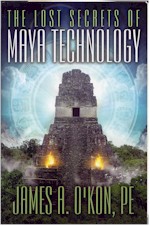 |
|
|
| ||||||
|
|
This page is the original source of this review, though you may also find it on Amazon or other sites. | ||
| Book Reviews Home | Free Audio Books | |
 |
Book Review of: The Lost Secrets of Maya Technology
Price: $13.65 Availability: Usually ships within 24 hours |
| Review of
The Lost Secrets of Maya Technology, by James A. O'Kon, P.E. (Softcover, 2012) (You can print this review in landscape mode, if you want a hardcopy) Reviewer: Mark Lamendola, author of over 6,000 articles. This was an enjoyable, informative read. My expectation when I began was just to understand a bit about the Mayans. I had not expected that I would find the information in the book relevant to today. My expectations were greatly exceeded. Now, you may be wondering what possible benefit this book can have to the reader. If you're a history buff, of course the big value is you get some great information on an ancient civilization. But what if you're looking for something relevant? Should you pass on this particular book? No. If you can understand that another culture was way ahead of the Western world for centuries, you then can question the orthodox view that the Western world is where human progress has always taken place. It isn't. And understanding that fact has profound implications for your worldview and how you interpret the events of today. What may be most important to understand is that Mayan technology was very advanced, yet it was not enough to save the Mayan civilization when their environment dramatically changed. Think of the major problems facing humanity today. Our technology can't save us from these; only a change in how we use our resources can. Today:
How did the Mayans handle their big challenges? They didn't. How will we handle ours? So far, we're not. That's worth noting. This "why the book is relevant" is from my own musings. The author didn't express any such sentiments. I think for the astute reader, he does not have to. I've read many "ancient civilization" books, and have found they tend to contain "amateurish" errors. This one doesn't fit the pattern. And while most such books do provide good information, there's always that nagging issue of why the author is qualified to expound on what the book says. I had no such nagging issue concerning me when I read this book. The author has high credibility, for several reasons. First of all, he's an experienced technologist. Specifically, he's a licensed Professional Engineer with several notable projects under his belt. My undergraduate is also in engineering; though I did not get a PE, I spent many years in technology and earned some significant awards. I'm still involved in the IEEE and other engineering-related fields. Any seasoned engineer can tell a brother engineer (or sister one) from a pretender. O'Kon is no pretender. Second, O'Kon writes from the perspective of someone who knows technology. The things he emphasizes are the very things an engineer would look at. That is not to say you must be an engineer to figure out what he's talking about. It is to say he looks at things from a fact-based perspective instead of just positing a viewpoint. He doesn't proselytize, he teaches. I won't go into the details of what the Mayan technology was, as O'Kon does that perhaps better than anyone else could. But just as a highlight, consider his painstaking analysis of a Mayan bridge. We get treated to a quick education on suspension bridges, along with photos and illustrations that clarify what he's talking about. O'Kon goes into many other areas, of course. For example, how do you make tools when you don't have any metal ores? How do you store and distribute water, when your topography is so porous you don't have lakes or rivers? How do you transport goods when you don't have horses or other beasts of burden? He answers these questions in fascinating detail. The text of this book runs 291 pages, and consists of 12 chapters and an epilogue. The bibliography is 6 and a half pages long, and includes extremely reputable sources. If that bibliography seems a tad short, please note that it does not include references to the author's own research. The author himself is a primary source, as evidenced by the many photos he took at the various archeological sites. As an engineer, he's also qualified to provide drawings; he provided many in this text. In my opinion, the information from the bibliography is a bonus, not a requirement. Had O'Kan wanted to, he could have excluded that material and simply presented his own findings. I like the fact that he looked at other sources to provide a more complete work that truly benefits the reader. | |
| |||||